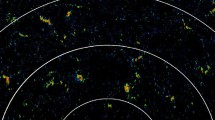Abstract
High-resolution magnetograms of the solar polar region were used for the study of the polar magnetic field. In contrast to low-resolution magnetograph observations which measure the polar magnetic field averaged over a large area, we focused our efforts on the properties of the small magnetic elements in the polar region. Evolution of the filling factor - the ratio of the area occupied by the magnetic elements to the total area - of these magnetic elements, as well as the average magnetic field strength, were studied during the maximum and declining phase of solar cycle 22, from early 1991 to mid-1993.
We found that during the sunspot maximum period, the polar regions were occupied by about equal numbers of positive and negative magnetic elements, with equal average field strength. As the solar cycle progresses toward sunspot minimum, the magnetic field elements in the polar region become predominantly of one polarity. The average magnetic field of the dominant polarity elements also increases with the filling factor. In the meanwhile, both the filling factor and the average field strength of the non-dominant polarity elements decrease. The combined effects of the changing filling factors and average field strength produce the observed evolution of the integrated polar flux over the solar cycle.
We compared the evolutionary histories of both filling factor and average field strength, for regions of high (70°–80°) and low (60°–70°) latitudes. For the south pole, we found no significant evidence of difference in the time of reversal. However, the low-latitude region of the north pole did reverse polarity much earlier than the high-latitude region. It later showed an oscillatory behavior. We suggest this may be caused by the poleward migration of flux from a large active region in 1989 with highly imbalanced flux.
Similar content being viewed by others
References
Babcock, H.D.: 1959,Astrophys. J. 130, 364.
DeVore, R. C. and Sheeley, N. R.: 1987,Solar Phys. 108, 47.
Hoeksema, T. J.: 1993,Geomagnetism and Geoelectricity, preprint.
Howard, R. and LaBonte, B. J.: 1981,Solar Phys. 74, 131.
Leighton, R. B.: 1964,Astrophys. J. 140, 1547.
Makarov, V. I. and Sivaraman, K. R.: 1989,Solar Phys. 123, 367.
Murray, N.: 1992,Astrophys. J. 401, 386.
Pope, T. and Mosher, J.: 1975,Solar Phys. 44, 3.
Sheeley, N. R.: 1964,Astrophys. J. 140, 731.
Stenflo, J, O.: 1970,Solar Phys. 13, 42.
Tang, F. and Wang, H.: 1991,Solar Phys. 132, 247.
Varsik, J.: 1994,Solar Phys., submitted.
Wang, H., Tang, F., Zirin, H., and Ai, G.: 1991,Astrophys. J. 380, 282.
Author information
Authors and Affiliations
Rights and permissions
About this article
Cite this article
Lin, H., Varsik, J. & Zirin, H. High-resolution observations of the polar magnetic fields of the sun. Sol Phys 155, 243–256 (1994). https://doi.org/10.1007/BF00680594
Received:
Revised:
Issue Date:
DOI: https://doi.org/10.1007/BF00680594




